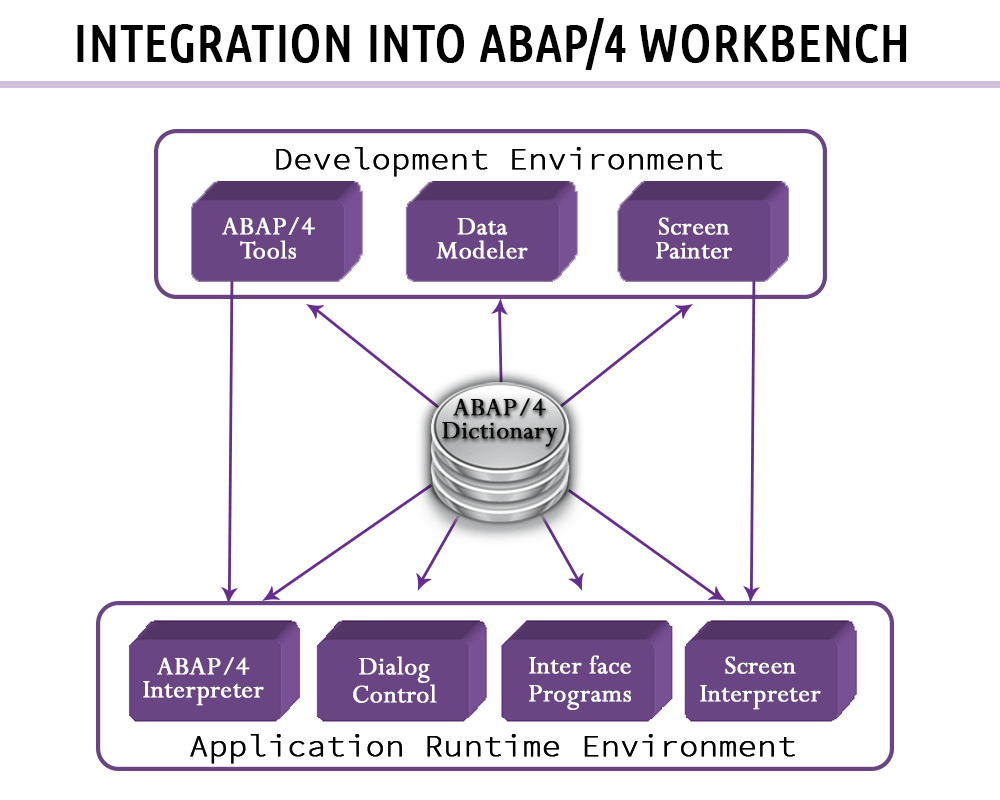What is Data Dictionary?
The Data Dictionary is a central source of information for the data in an information management system. Its primary function is to assist in the creation and management of data definitions (or “metadata”).

In this SAP ABAP Data Dictionary tutorial you will learn: :
3 levels of ABAP Dictionary
Objects in ABAP Dictionary are stored at three different levels to support their reusability. These three levels are:
- Tables and structures
- Data elements
- Domains
Let’s take a look at them in more detail –
Domains
- Describe the specifications of a field in the table
- Specify a range that describes the allowed data values for fields
- Fields related to the same field (through the data elements assigned to them) will change when there is a change to that field
- • Ensure consistency.
Ex. Purchasing document number (EBELN)

Data Elements
- Describe the role of a field in a technical context
- Fields with the same semantic meaning can refer to the same data element
- Contains information about fields.
Ex. Purchasing document number (EBELN)
[data:image/svg+xml,%3Csvg%20xmlns=’ http://www.w3.org/2000/svg’ viewBox=’0 0 577 488′></svg>](data:image/svg+ xml,<svg xmlns=’http://www.w3.org/2000/svg’ viewBox=’0 0 577 488 ‘%3E%3C/svg%3E)
Tables
- Represents the database tables where the data is actually stored.
- Tables can be defined independently of the database in ABAP Dictionary.
- Table fields are defined with SAP ABAP data types (database independent) and their length.
[data:image/svg+xml,%3Csvg%20xmlns=’ http://www.w3.org/2000/svg’ viewBox=’0 0 600 513′></svg>](data:image/svg+ xml,<svg xmlns=’http://www.w3.org/2000/svg’ viewBox=’0 0 600 513 ‘%3E%3C/svg%3E)
Structures
- A structure is a record declaration that does NOT correspond to a database table.
- Similar to user-defined data types.
- Defined like a table and can then be retrieved from ABAP programs.
- Structs contain data only during the runtime of the program.

ABAP Dictionary’s Aggregated Objects
Aggregated Objects in English means consisting of many components. In ABAP Dictionary, aggregated objects are objects that include information from multiple tables in the system.
Composite objects include:
- Views (Views)
- Search Help
- Lock Objects
Let’s go into the details of each object.
Views
- View in SAP – ABAP is used to summarize data distributed in multiple tables
- A view’s data is not physically stored. Instead, a view’s data is retrieved from one or more other tables
- It is customized for the needs of a specific application

Search Help
- A Search Help is a tool that helps you find data records in the system
- An efficient and easy-to-use search engine that helps users in cases where the key of a record is unknown.

Lock Objects
- Lock mechanism concurrent access to the same data record by two users in SAP system is synchronized using lock.
- Locks are set and released by calling some specific function modules. These function modules are automatically generated from the definition of key objects in the ABAP/4 Dictionary.
Function modules :
- Enqueue_<obj name> – to lock the table,
- Dequeue_<obj name> – to release the lock.

Important Transactions Code (T-Code) :
- SE11 : Data Dictionary Initial Screen (SE12 Display only)
- SE13 : ABAP Dictionary : Technical Settings
- SE14 : Database Utility
- SE15 : Repository Information System
- SE16 : Data Browser
- SE17 : General table Display
- SE55 : Table View Maintenance
- SM30 : Table Maintenancesource: guru99.com
